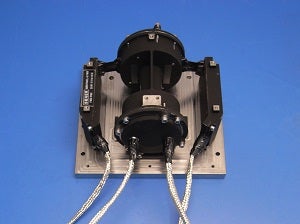
One of the primary objectives for the Sentinel-3 mission, part of the Copernicus European Earth observation programme, an initiative led by the European Commission in collaboration with the European Space Agency (ESA), is to determine land-surface temperature with high-end accuracy and reliability.
On 16 February, the first Sentinel-3 satellite will be launched. It will be followed, later on, by a second, twin satellite, the two in conjunction providing maximum coverage.
SENER engineering and technology group has contributed to the technology for this probe by engineering the selector mirror mechanism of a flip mirror device (FMD) for the sea and land surface temperature radiometer (SLSTR).
The FMD selector mechanism alternates a mirror between two positions at high-speed and with extreme precision, allowing the SLSTR to use a dual-vision technique that provides greater coverage than its predecessor (the Envisat/AATSR probe).
SENER developed the concept both for the mechanism and for its control electronics, leading to a mechatronic device (the mechanism and its electronics), whose precision, repeatability and stability have a direct effect on the quality of the images supplied by the instrument. This mechatronic device is capable of very high-rotational speed, which is essential to provide the specified sequence of images throughout the complete orbit. The equipment must maintain its operation through more than 700 million cycles during the seven years of the instrument’s useful life.
SENER’s global involvement in Copernicus
SENER also contributed to the Copernicus programme’s previous satellites, supplying for Sentinel-1A the deployment system for the five panels of the Synthetic Aperture Radar (SAR) antenna, which has nominally been in operation since its launch in April 2014. For Sentinel-2, whose first satellite was launched in June 2015, SENER developed the shutter and calibration mechanism (SCM) for the multi-spectral instrument (MSI) that allows this innovative and high-resolution multi-spectral satellite camera (with 13 bands) to be properly calibrated.
What is more, the engineering and technology group is also contributing with technology for the future satellite Sentinel-5, where it is responsible for the optical bench of the UVNS SWIR subsystem (in ultraviolet and infrared ranges), which includes a high-dimensional stability structure and the parts that screen and fix the optical elements.
Mechanisms are one of SENER’s specialties in Space, where it provides engineering and production services in five areas of activity: electromechanical components and systems, navigation and attitude control systems (GNC/AOCS), optical systems, microgravity and life support systems, and astronomy. SENER has worked in electromechanical systems and mechanisms since the 1970s, providing key components for missions such as Hubble, Ulysses, Eureca and Soho, and, more recently, Rosetta, Metop, Pleiades, Gaia, BepiColombo, Exomars and Solar Orbiter.
SENER is a global benchmark in this sector, with nearly 50 years of experience and more than 270 devices and systems for satellites and space vehicles for Nasa, the ESA, JAXA and Roscosmos, all without a single fault.

